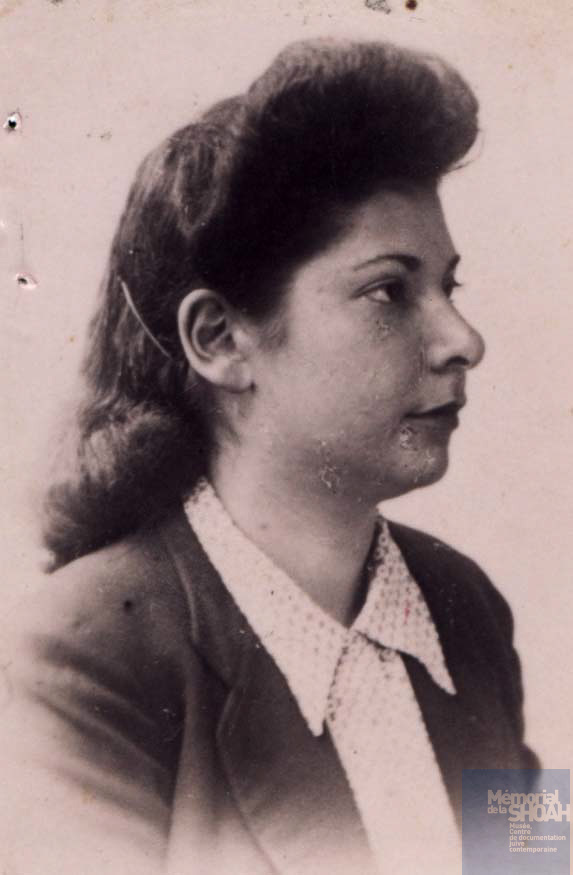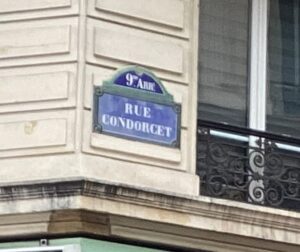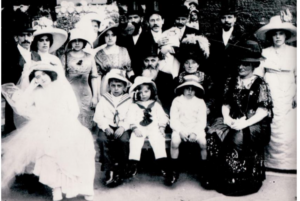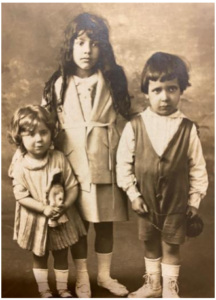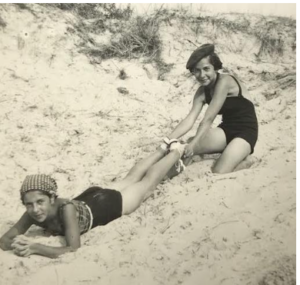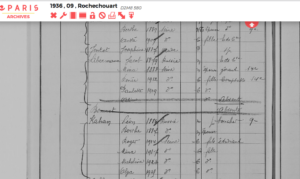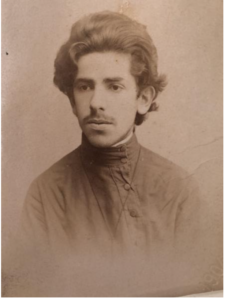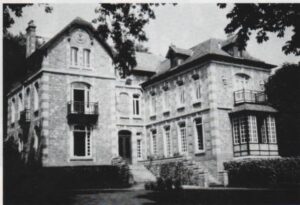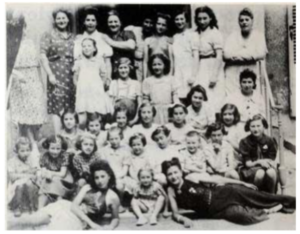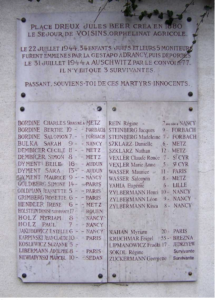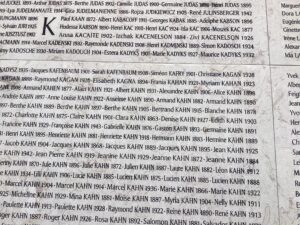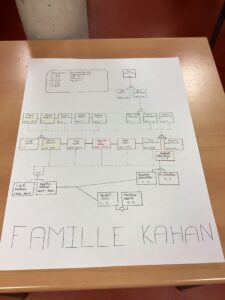Myriam dit Micheline KAHAN (1923-1944)
Photo of Myriam Kahan
© Shoah Memorial
Introduction to the project
We are a group of twelve 9th grade students at the Jean Jacques Rousseau secondary school in Darnétal, near Rouen in the Normandy region of France. At the beginning of the new school year in September 2022, we were invited to take part in a ‘Making History’ workshop, and we decided to join in. The idea of the workshop is to write the biography of a person who was deported on Convoy 77 on 31 July 1944, during the Holocaust.
During the workshop sessions, we carried out research on both hard copy records and online sources. Our supervisors were our documentary resource teacher, Ms. Petit, and our history and geography teacher, Ms. Debétaz.
Why Myriam?
First of all, we looked to see if any of the people on the Convoy 77 deportation list came from Normandy. We found Denise Holstein, who is 95 years old at the time of writing, but her biography had already been published on the Convoy 77 website.
We therefore looked through the list of people arrested at the same time as her in the Louveciennes children’s home and came across the name of Myriam Kahan, who was 21 years old.
We began by studying the records provided by the Convoy 77 team and then contacted various other sources, including the town hall, the Shoah Memorial and in particular the French Defense Historical Service in order to request further information. Some of our attempts were unsuccessful. With the help of the Convoy 77 team, we then broadened the scope of our investigation and made contact with a number of key people who helped us to add to our research:
- Inès Goutenmacher: We found Inès Goutenmacher’s detailed family history research on the internet. She is one of Myriam’s descendants. She is the great-great-granddaughter of Myriam’s sister Mina. Her final year dissertation was based on family archives and other sources, and in particular on oral testimonies from family members. We managed to get in touch with her via social networks.
- Denise Holstein, a Convoy 77 survivor who lives in Antibes, in the Alpes-Maritimes department of France. Thanks to Mr. Richard Niderman, we were able to contact her and talk to her about the Myriam she remembers.
- Françoise Botoit, a history and geography teacher and member of the Cercle d’études de la Déportation et de la Shoah (Deportation and Holocaust Study Group), who worked extensively with Denise Holstein and wrote the book De Rouen à Auschwitz (From Rouen to Auschwitz), published by Ovadia in 2015, as well as a report on the children’s home at Louveciennes, UGIF Centre 56, 1943-1944.
The Kahan family, before the war
The name Kahan is a variant of the name Cohen, which means ‘devoted’ in Hebrew. It is a patronym from which other surnames are derived.
It can be spelled with a C or a K, depending on the country.
Myriam, also known as Micheline, was born on October 8 1923, at 47 au rue Condorcet in the 9th district of Paris.
47 rue Condorcet, in the 9th district of Paris.
According to Inès Goutenmacher, the Kahans were an upper-middle-class family, known in France as the “haute bourgeoisie”.
Myriam’s father Leib, known as Léon, Kahan, was born in Liedov in Russia in August 1886.
According to the Shoah Memorial, he worked as a butcher at 44 rue Durantin in the 9th district of Paris.
Inès describes Leib as an erudite, well-read man who spoke several languages: Russian, German, Greek, Latin, ancient and modern Hebrew and Yiddish.
Leib left Kharkov for Paris in 1905, and soon began to use the name Léon. He ran a kosher butcher’s shop and owned a number of properties.
In 1910, he married Berthe Gorsd, who was born on February 9, 1887 in the 4th district of Paris. Léon was not yet a French citizen, and as a result, Berthe lost her French nationality when she married him.
Léon Kahan and Berthe Gorsd’s wedding in 1910 ©Ines Goutenmacher
The couple had five children, all of whom were born in Paris: Noémie, born on May 30, 1912; Roger, born on July 3, 1914; Mina, born on February 4, 1917; Myriam, born on October 8, 1923 and Olga, born on October 24, 1925.
Photo 1: From left to right, Mina, Noémie and Roger Kahan 1920 ©Ines Goutenmache
Photo 2: Micheline and Olga Kahan ©Ines Goutenmacher
According to the 1936 census of Paris, the family lived at 52 rue de la Tour d’Auvergne in the 9th district during the Second World War, with the exception of Noémie, who was married to Georges Pliskine and lived with him elsewhere.
Inès says that Myriam had a happy childhood. In her dissertation, she mentions a family vacation at Le Crotoy in July 1939, not long the French national mobilization order was issued on September 2.
Myriam was in school in Paris at the time. According to Inès, she was intending to study journalism and was probably studying for her baccalaureate at the Edgar Quinet high school on rue Duperré in the 9th district of Paris. Her sister Mina went to the same school.
During the war
In the summer of 1940, when the Germans occupied France, the Kahan family moved to the free zone in the southern half of the country. From June 23 to August 2, 1940, they stayed with a Mr. de Conchard in Douzillac, in the Dordogne department. Over the course of the Second World War, between 1939 and 1945, this little village France took in more than 1,000 refugees.
The Kahan family then returned to Paris. Leib, Myriam’s father, was arrested in 1943 and interned at the Beaune-La-Rolande camp in the Loiret department of France. He was transferred to Drancy camp, to the north of Paris and in the Seine-Saint-Denis department, on March 9, 1943. From there, he was deported to Auschwitz on Convoy 59 on September 2, 1943. He never returned to France.
Portrait photo of Leib as a student ©Ines Goutenmacher
Myriam was left in Paris with her mother and her youngest sister, Olga. According to Inès, Myriam and Olga joined the UGIF, the Union Générale des Israélites de France, or General Union of French Jews, an organization founded by the Vichy government on November 21, 1941. Perhaps, by doing so, they hoped to help their father in some way.
The UGIF home in Louveciennes
Myriam worked at the UGIF home in Louveciennes in the Seine-et-Oise department of France. According to Denise Holstein, she was a supervisor for the children who were staying there.
The UGIF had converted a former agricultural orphanage into a children’s home called “Le séjour des Voisins”, (named after a hamlet called Les Voisins) which took in “isolated” or “lone” Jewish children whose parents had been arrested and so-called “blocked” children. These children were already known to the Gestapo, which wanted to keep track of them and thus did not allow them to be placed with foster families. As of February 1943, the German and French authorities had been holding them hostage, and they were monitored closely and subject to deportation at any time. The Germans subsequently requisitioned the building, and the children and staff relocated to a large villa at 18 rue de la Paix in Louveciennes.
The home in Louveciennes © Denise Holstein
Living conditions in the home slowly became worse. Denise Holstein, who was there at the time, describes the manager, Mr. Louis, as “a hard man, a believer in educating children by slapping them”, and his six-year-old daughter Michèle as “a little pest”. The house was not designed to accommodate such a large number of people. The children were short of clothes and often left the table still feeling hungry, whereas the manager and his family always had plenty to eat. Denise Holstein only found out much later on that the cook had been selling food on the black market.
On top of the day-to-day hardships, the children were also scared, as the Germans carried out weekly checks.
Myriam was in charge of a small group of children, although we do not know their names or ages, and was able to spend weekends with her family in Paris.
Denise remembers Myriam as a very kind young woman with whom she got on well. She was very gentle with the children, but never spoke to Denise about her family.
Supervisors and children in Louveciennes. Myriam is in the top row, second from the right
©Ines Goutenmacher
The arrest
On July 22, 1944, at six o’clock in the morning, before the curfew was over, Aloïs Brunner, who was the commandant of Drancy camp and in charge of deporting Jews from France, arrived at Louveciennes with his men. They arrested the manager and his family, the supervisors and all forty children. With him were a group of Jewish internees known as “les pisteurs” (trackers, or tracers). The supervisors quickly woke up the children and bundled as many things as they could into blankets. They were all then taken to Drancy, although the manager and his family were soon released.
Denise was not assigned to the same block as Myriam during their time in Drancy. She supposes that Myriam was in another block, together with a group of children.
Of the forty children arrested that day, thirty-four, together with their supervisors, were deported to Auschwitz- Birkenau on Convoy 77 on July 31, 1944.
We have very little information about what happened to Myriam after she was arrested. We do know, however, that she was not deported in the same cattle car as Denise Holstein. We also know that her sister Olga, who was arrested at the UGIF home in La Varenne on the same day, was aboard the same train.
Myriam’s death certificate, issued much later by Paris City Hall, states that Myriam Micheline Kahan officially died on August 5, 1944 in Auschwitz. In reality, she was murdered soon after she arrived.
Léa Varech, an Auschwitz survivor whose testimony is quoted in Inès’s dissertation, confirms this. She stated that she “saw the two sisters go into the gas chambers as soon as they arrived. They were holding the children’s hands. The Nazis had asked them to let go, but they had refused to do so.”
Memorial plaque at Louveciennes
©Benedicte Zukerman
After the war
Roger, Mina and Noémie, Myriam’s brother and sisters, got back together in Paris in April 1945.
Roger took care of his mother, Berthe, who had been severely affected by the tragedy.
They then began the process of trying to trace the whereabouts of the missing family members. On February 28, 1949, they applied to the Ministry of Veterans and Victims of War to have them officially recognized as “non-returned” persons.
The Wall of Names at the Shoah Memorial in Paris
The Kahan family tree, drawn by the students
We would like to thank everyone who kindly sent us photos and gave us permission to publish them.
Sources:
- French Defense Historical Service, Victims of Contemporary Conflicts Archives Division
- Paris departmental archives service
- Inès Goutenmacher’s dissertation
- “Je ne vous oublierais jamais, mes enfants d’Auschwitz … ” (“I shall never forget you, my children of Auschwitz…”) by Denise Holstein, Edition n°1, 2005.
- De Rouen à Auschwitz. (From Rouen to Auschwitz) by Françoise Botoit. Ovadia, 2015.
- Telephone conversation with Denise Holstein
- Visit to the Shoah Memorial in Paris


 Français
Français Polski
Polski